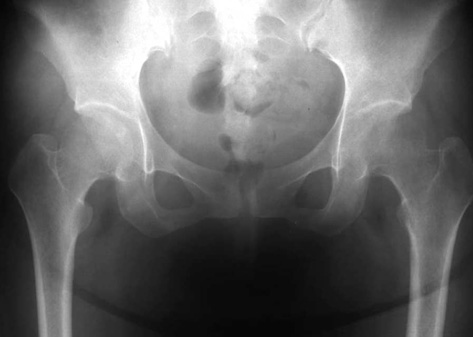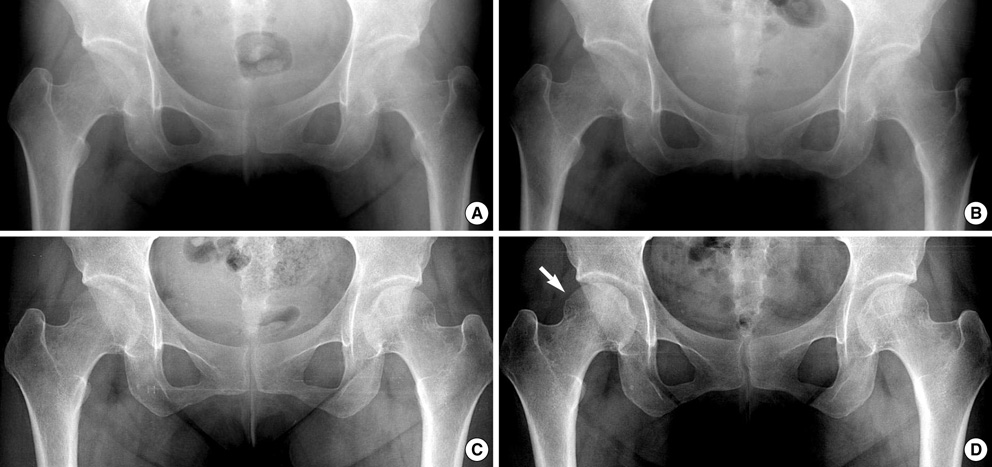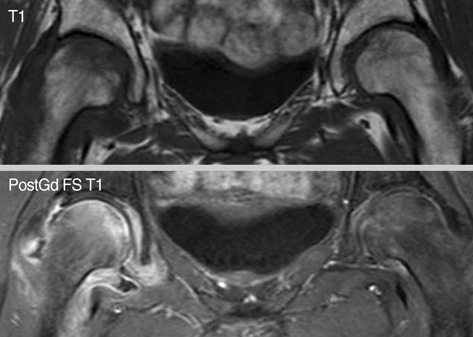J Korean Med Sci.
2010 Jan;25(1):192-195. 10.3346/jkms.2010.25.1.192.
CT Evidence for Subchondral Trabecular Injury of the Femoral Head in Transient Osteoporosis of the Hip: A Case Report
- Affiliations
-
- 1Department of Orthopaedic Surgery, Inchon Medical Center Hospital, Inchon, Korea.
- 2Department of Orthopaedic Surgery, Cheju National University Hospital, Jeju, Korea.
- 3Department of Orthopaedic Surgery, Seoul National University College of Medicine, Seoul, Korea. oskim@snu.ac.kr
- 4Department of Orthopaedic Radiology, Seoul National University College of Medicine, Seoul, Korea.
- KMID: 1713858
- DOI: http://doi.org/10.3346/jkms.2010.25.1.192
Abstract
- A 28-yr-old woman presented with both hip pain that started sequentially during the peripartum period. Diagnosis of transient osteoporosis of the hip (TOH) was made based on typical findings of plain radiographs and magnetic resonance images. The subchondral trabeculae of the femoral head were evaluated on serially taken coronal multiplanar reformation computerized tomogram images. At 4 weeks after pain onset, marked decrease in the sclerotic density with irregular discontinuation was observed in the primary compression trabeculae. At 12 weeks, a focal area of irregular thickening of trabeculae was observed. At 20 weeks, sclerotic density of trabeculae recovered markedly and the focal area of irregular trabecular thickening disappeared. At 1 yr, subchondral trabeculae recovered almost completely. The evidence of subchondral trabecular injury was observed in the femoral heads of TOH.
Keyword
MeSH Terms
Figure
Reference
-
1. Guerra JJ, Steinberg ME. Distinguishing transient osteoporosis from avascular necrosis of the hip. J Bone Joint Surg Am. 1995. 77:616–624.
Article2. Song WS, Yoo JJ, Koo KH, Yoon KS, Kim YM, Kim HJ. Subchondral fatigue fracture of the femoral head in military recruits. J Bone Joint Surg Am. 2004. 86:1917–1924.
Article3. Miyanishi K, Kaminomachi S, Hara T, Maeda H, Watanabe H, Shimizu A, Torisu T. A subchondral fracture in transient osteoporosis of the hip. Skeletal Radiol. 2007. 36:677–680.
Article4. Miyanishi K, Yamamoto T, Nakashima Y, Shuto T, Jingushi S, Noguchi Y, Iwamoto Y. Subchondral changes in transient osteoporosis of the hip. Skeletal Radiol. 2001. 30:255–261.
Article5. Mitchell DG, Rao VM, Dalinka MK, Spritzer CE, Alavi A, Steinberg ME, Fallon M, Kressel HY. Femoral head avascular necrosis: correlation of MR imaging, radiographic staging, radionuclide imaging, and clinical findings. Radiology. 1987. 162:709–715.
Article6. Noorda RJ, van der Aa JP, Wuisman PI, Davis EF, Lips PT, van der Valk P. Transient osteoporosis and osteogenesis imperfecta. A case report. Clin Orthop Relat Res. 1997. 337:249–255.
Article7. Karagkevrekis CB, Ainscow DA. Transient osteoporosis of the hip associated with osteogenesis imperfecta. J Bone Joint Surg Br. 1998. 80:54–55.
Article8. Plenk H Jr, Hofmann S, Eschberger J, Gstettner M, Kramer J, Schneider W, Engel A. Histomorphology and bone morphometry of the bone marrow edema syndrome of the hip. Clin Orthop Relat Res. 1997. 334:73–84.
Article9. Todd RC, Freeman MA, Pirie CJ. Isolated trabecular fatigue fractures in the femoral head. J Bone Joint Surg Br. 1972. 54:723–728.
Article10. Yamamoto T, Schneider R, Bullough PG. Subchondral insufficiency fracture of the femoral head: histopathologic correlation with MRI. Skeletal Radiol. 2001. 30:247–254.
Article
- Full Text Links
- Actions
-
Cited
- CITED
-
- Close
- Share
- Similar articles
-
- The 1 Case Report of the Transient Osteoporosis of the Hip
- Transient osteoporosis of the hip with a femoral neck fracture during follow-up: a case report
- Current Research on Subchondral Insufficiency Fracture of the Femoral Head
- Subchondral Insufficiency Fractures of the Femoral Head
- Changes in the Microstructural and Mechanical Properties in the Medial Condyle of Human Distal Femur in Advanced Osteoarthritis






